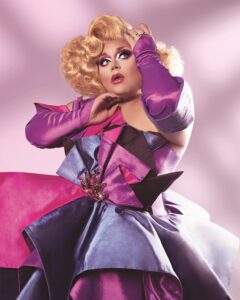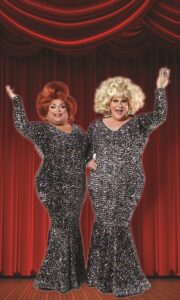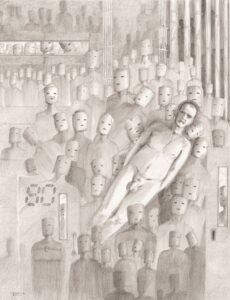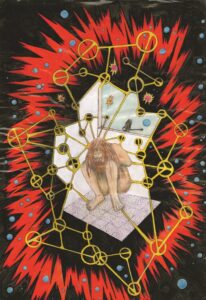Ginger Minj Serves It Up
The poster advertising Ginger Minj’s current show at the Art House (241 Commercial St., Provincetown) features only a photo of the RuPaul’s Drag Race superstar herself. But The Broads’ Way, which is running through Sept. 2, is very much a two-person show: fellow queen Gidget Galore joins Minj in a rousing run through some of Broadway’s big diva moments.

It’s a feel-good extravaganza with all the physical humor and sight gags that add up to a great drag show. Like her costar, Galore is also a talented singer and comedian. She holds her own in her scenes with Minj, as well as alone in the spotlight. But Minj is the undeniable star, commanding attention every moment she’s on stage.
Like her fellow Drag Race stars Jinx Monsoon and Ben De La Creme, Minj is a theater-trained actor. “My first role as a baby was playing a baby in Fiddler on the Roof,” Minj tells the Independent. This past spring, she played Albin in La Cage Aux Folles at Music Theater Works near Chicago. Both the show and Minj’s performance were critical successes.

In her Art House show, Minj ambitiously serves up both “As If We Never Said Goodbye” from Sunset Boulevard and “Rose’s Turn” from Gypsy, two classics of the Broadway diva canon. Fortunately, Minj does both numbers justice, and made me wonder what other great roles she could play: I’d love to see her as the Emcee in Cabaret when Eddie Redmayne eventually departs its new Broadway-bound production.
And she’s an author, too. Her new cookbook, Southern Fried Sass, reveals the most valuable lessons she’s learned from years in drag and the pearls of wisdom she’s gleaned from her grandmother’s personal brand of Southern resilience.
“The throughline is if you’re given something you take it and you make it better before you give it back,” says Minj. “If it’s a recipe or a car, it doesn’t matter. You nurture it and return it better than you borrowed it.”
The Broad’s Way plays Wednesday through Saturday at 9:30 p.m. Tickets are $50 to $75 (plus fees) at provincetownarthouse.com. —James Judd
Megan Hinton Pays ‘Homage’ at Farm Projects
In her exhibition, “Homage”, at Farm Projects (355 Main St., Wellfleet), Megan Hinton pays tribute to her parents, who both died within the past year, and a range of painters from the past and present who function as different kinds of forebears.

As she did in her public art project Yokel at Wellfleet Preservation Hall last year, Hinton continues to work with found materials and an overarching idea built in accumulative moves.
“I like seriality and having a working methodology,” says Hinton. The new exhibition finds her more firmly working within the territory of painting, which Hinton says she “abandoned” in 2018. She spent the next several years working in collage, drawing, performance, and sculpture. “It was all really experimental and fun,” says Hinton. “I feel like I’ve arrived back to painting in a way that is unique, but I never would have gotten here if I hadn’t done all that.”
Hinton began this recent series of drawings and paintings by thinking about objects for which her parents had a preference or aversion. She then located the objects within the paintings of other artists, created ink drawings of them, and transferred the images to panels cut in the shape of the objects and stretched with her own discarded paintings.
In one painting of Van Gogh’s bed, Hinton remembers an antique bed from her childhood and her mother’s love of antiques. In an image of a basketball player in motion, she reflects on her father, an athlete and coach with whom she often played sports. In another image, she copied a watermelon from a Wayne Thiebaud painting as a representation of her mother’s dislike of the fruit. (“I never really understood it,” says Hinton. “Most of the universe likes watermelon.”)

The images are painted sparsely with interventions deferring to the colors, shapes, and marks of Hinton’s discarded paintings. “I was challenging myself to hold back and be gentle and consider if I could work the underpainting into the composition,” she says. In her artist statement, Hinton says that the remnants “act as a metaphor for loss, impermanence, and legacy.”
Viewed together, the works feel like archeological artifacts from a project of personal excavation. There are imprints of her parents, her art heroes, and failed projects from her artistic past. But new marks and a self-directed process breathe life into the images. The objects hang in the balance of something that was and something coming into being.
The exhibition opens on Friday, Aug. 4 and runs through Monday, Aug. 14, with a reception on Saturday, Aug. 5 from 5 to 7 p.m. See farmprojectspace.org for information. —Abraham Storer
Nina Totenberg Makes Time for Wellfleet
For the past decade, National Public Radio legal affairs journalist Nina Totenberg has taken a much-needed vacation to the Outer Cape every summer. But while Totenberg tries to rigorously avoid work commitments during those sacred times, she’s accepted an invitation from the Wellfleet Public Library to give its annual Distinguished Speaker address on Thursday, Aug. 10. (Tickets for the talk, which will take place at the Wellfleet Congregational Church, were sold out as of press time.)

Totenberg is coming out of a rare, inverted period in her professional life as a subject rather than as a reporter. Her 2022 bestselling memoir, Dinners With Ruth, details Totenberg’s longstanding friendship with the late Justice Ruth Bader Ginsburg, which began before either of them held such prominent positions in their respective fields.
It was Totenberg’s first book, despite plenty of other opportunities, and probably her last. “Let’s put it this way,” she says. “I’m very glad it was on the bestseller list and that it was successful. And I’m very glad they paid me well to write it, and they’ve made back their money. But would I write another? No.” (There’s one caveat: if Totenberg has another manuscript in her, “it’s going to be a mystery story,” she says.)
Totenberg wrote Dinners With Ruth without taking any time off from her day job covering the nation’s highest court for NPR, a beat she’s presided over since 1975. She has broken innumerable high-profile scoops — perhaps most notably Anita Hill’s sexual harassment allegations against then-Supreme Court nominee Clarence Thomas in 1991 — and is considered one of the “founding mothers” of public radio.
Last fall, Totenberg did a whirlwind press tour on both coasts but prefers the reporter’s side of the question-and-answer equation. “It’s not interesting to hear yourself talk all the time,” she says.
While the book received favorable reviews, it also garnered criticism from NPR’s own public editor over whether Totenberg’s chumminess with top judicial sources compromises her ability to write about the court fairly. “Give me a break, will you?” says Totenberg in response to such questions. “Part of what you do when you’re a reporter is to get to know people. You don’t get rid of them once you know them.”
The court is a more complicated assignment than ever these days, and Totenberg sometimes daydreams about expanding her coverage. “I’m not sure I have the physical fortitude to cover a campaign, but I would love to do it,” she says. “And I’m sorry I can’t cover the judiciary or the Justice Dept. the way I used to. I would love to be covering some of the Trump trials, for example. But I just don’t have time.” —Amelia Roth-Dishy
Looking at Art by the Imprisoned
“On the Inside,” a group show featuring work by currently incarcerated LGBTQ artists, has been on display at 229 Commercial St. in Provincetown since June 29. Curator Tatiana Von Furstenberg will discuss the project at the Provincetown Arts Society (466 Commercial St.) on Friday, Aug. 4 at 6:30 p.m.

Composed mostly on letter-sized paper with materials including dull pencils, pen ink tubes, and colored drink powder, the works in “On the Inside” bear witness to the artists’ potent imagination from inside prisons. The limitations of the available media give life to masterworks of light and shading. Many scenes are set outside the recognizable prison landscape where the artists are currently held, unfolding in the private rooms and abstract streets of freedom instead.
Von Furstenberg gathered material for the exhibit through a call in the monthly Black & Pink newsletter, which circulates news, writing, and ideas by and for incarcerated LGBTQ people. She eventually received over 4,000 submissions.
A narrative woven from the letters accompanying the art that Von Furstenberg received unfolds on the walls of the exhibition. “My words don’t really matter,” she says. “I’m just the vehicle or conduit for these artists.”
Von Furstenberg also points out how the works combine medium and message. “Typically, the paper used was institutionalized in some way,” she says, noting that artists drew on the backs of disciplinary forms or other prison-issued scrap paper. “I find the very act of taking a piece of paper that is supposed to keep you down, turning it over, and expressing yourself to be such an act of protest.”

The show was first exhibited at Abrons Arts Center in New York City in 2016 and later at Craft Contemporary in Los Angeles in 2019. Over the past two years, a selection from the larger collection has traveled to colleges and universities throughout the U.S. before its current installation in Provincetown.
“As an activist, my relationship to institutions has been one of mistrust,” Von Furstenberg writes in a project statement. “I was conflicted about taking art that narrowly escaped one institution, just to hang it on the walls of another … [T]he act of defiance inherent in each piece, however, has the power to subvert the gallery space into an active space of protest. It demands to be seen.”
See ontheinsideart.com for more information about the project. —Amelia Roth-Dishy
A Provincetown Jazz Festival Debut
Pianist and vocalist Zahili Gonzalez Zamora, who makes her Provincetown Jazz Festival debut at the Provincetown Art Association and Museum (460 Commercial St.) on Tuesday, Aug. 8, remembers growing up in Manzanillo, Cuba, and waking up in the middle of the night to her grandfather singing.

“He was a big band singer,” she says. “He would come back from a gig and serenade my grandma.” Her family also sang together on Sunday afternoons, and Zamora says she became curious about music herself when she was three years old.
“I would bring up my hands and reach out to the piano,” she says. “My grandma was the one who noticed. She was like, ‘Oh my gosh. This kid, she cannot get away from the piano!’ ”
Zamora’s grandmother enrolled her in Cuba’s National School of Music. In 1998, she graduated with a piano performance degree.
While on a tour in Canada with the all-female salsa band D’Talle, she and the group decided to settle in Toronto and Vancouver. After leaving the group in 2008, Zamora traveled to Southeast Asia. While performing with jazz musicians in Macao, Zamora says she became aware of “a different kind of freedom” when she heard their music and followed her new passion for jazz to Berklee College of Music. She graduated in 2017 and joined its piano faculty in 2019.
Zamora’s musical style incorporates several cultural threads. Cuban schools, she says, teach only classical music; Afro-Cuban rhythms and melodies are learned on the streets. Along with those early influences, her playing style has come to draw upon the improvisatory standards of the Great American Songbook. The result is a “great mix,” she says.
Improvisation is also a central component of Zamora’s music. “If you feel happy, it’s going to sound one way,” she says. “If you feel sad, it’s going to sound one way. If you feel mysterious, if you feel longing — you can make out of the chord progression something that sounds different every time.”
Her style reflects her personal musical heritage. “You listen to classical music from Cuba today and you hear the lyricism of Chopin on the right hand and the very rhythmic left hand that comes from the African heritage. That’s pretty much what I feel like I am.”
Tickets for Zamora’s concert are $35. See provincetownjazzfestival.org for information. —Dorothea Samaha



